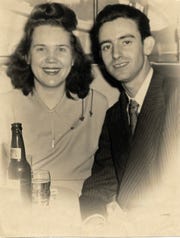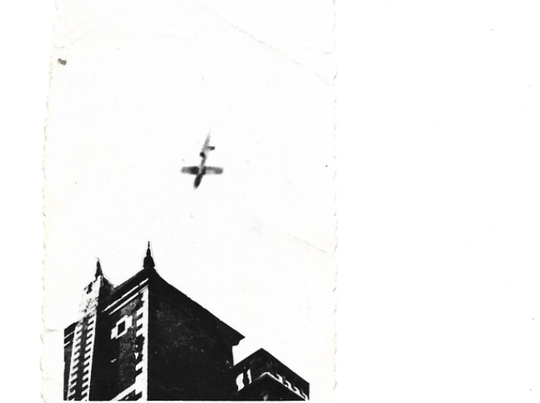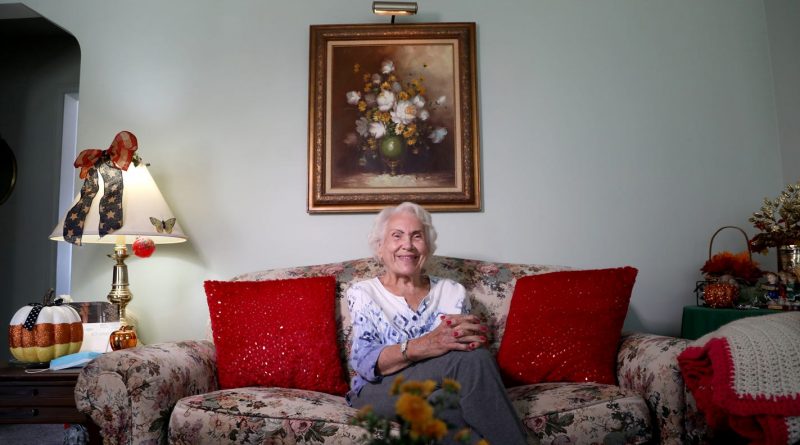A World War II bride tells her story of strength and perseverance
[ad_1]
DETROIT – Alice Lawson can still remember the bombs whizzing over her head, 75 years later.
It wasn’t how she imagined life as a newlywed would be.
Lawson, a teenager in Liège, Belgium, found love in an unlikely place: The middle of a war zone.
“He (her husband) looked at me and then came over and presented himself,” she said. “That was it. Then we started dating.”
She’s one of more than 100,000 women from continental Europe who ended up as war brides. Much like Rosie the Riveter, cadet nurses, and Susan Ahn Cuddy — the first female gunnery officer in the navy — war brides contributed in their own ways to change American history.

Alice and John Lawson in a photo taken in 1948. Lawson, originally from Belgium, met her husband during World War II in Belgium where both were in the medical field. During the war Lawson and her family helped hide Jewish people from the Nazi’s saving dozens from going to concentration camps. She married her husband a few days after VE Day in May of 1945. (Photo: Eric Seals, Detroit Free Press)
The U.S. government passed the Immigration Act of 1924, which restricted immigration quotas from Europe and completely cut off immigration from Asia. This act stemmed from the 1882 Chinese Exclusion Act and created the visa system for immigrants.
As World War II ravaged on, many American soldiers found themselves in lengthy deployments overseas. It’s easy to imagine how GIs were looking for companionship through the locals and ended up finding love in the process.
In fact, so many GIs married women from overseas that the U.S. government created the War Brides Act of 1945 and 1946.
The 1945 act expedited the immigration process for mainly European war brides and their children. The 1946 act extended this privilege to Asian war brides who were previously barred from coming to the U.S. due to the Chinese Exclusion Act.
Lawson’s story was recently chronicled by the language-learning app Babbel. The app archived the Michigan war bride’s story in their magazine and gave readers an insight into how she learned English. Stories of other war brides and their experiences were also published.
Lawson still lives in the same Lincoln Park, Michigan, home she bought with her husband for $5 in 1950. Her living room mantle displays pictures from the past and present, giving visitors a visual family tree.
Before the war started, Lawson’s childhood was simple. Although she grew up in an industrial city, she would spend weekends visiting her grandparents’ orchard in the Belgian countryside. On Sundays, her family went into town where the main cathedral stood. They would go to the movies and eat ice cream at the park.
Another ’80s comeback: 1987 Chevy Camaro reported stolen 32 years ago finally recovered in Indiana reservoir
‘Boy, if he wants to do all that he must really care’
The calmness of her life changed as political tensions in Europe heightened. By the mid-’30s, Lawson’s father knew the war was coming, so he built a bomb shelter in the family backyard.
Her family helped those who were persecuted by the Gestapo and Nazis. Lawson said there was a church basement in her hometown where many people went into hiding. Her family made food baskets for those crammed in the basement. She remembers leaving her house at night, with her older sister and father, to help American and British soldiers.
Lawson spent her teenage years hiding from bombs and working with her father on the Belgian streetcar system. Lawson’s life and experiences molded her to be a tough, independent woman. Amid the war, she graduated from college and became a nurse.
She said becoming a nurse allowed her to get a Red Cross card, which helped her maneuver through police checkpoints.
One day, a 21-year-old Lawson and her mother were in town after watching a movie in 1945. This is when Lawson met the love of her life.
Lawson’s soon-to-be husband, John, was in Belgium during the war. He worked in an army division that handled logistics. He saw Alice from across the street and approached her. A few months later, they married.
John converted to Catholicism in the army, and Alice’s family said he converted to be with her. She still keeps the memories of going to midnight mass together and remembers his communion taking place in the church she grew up in.
“I thought to myself, boy, if he wants to do all that he must really care, you know?” Alice said.
Language barrier, but electrifying romance
Although there was a language barrier between the couple, the romance was electrifying in the relationship. John secretly got Alice’s measurements and sent them to his sister, who bought an American wedding dress and sent it to Belgium for the wedding.
After the wedding, the Lawsons spent two weeks in the quiet Belgian countryside for their honeymoon. Alice still remembers her husband’s reactions when seeing the rolling European countryside for the first time.
In 1946, Alice left her family and boarded a train in Liège, which brought her to a port in Antwerp. This was the day she left everything and everyone she knew, she was going to move to America with her new husband.
Alice said she still remembers the isolating fear and loneliness cloaking her body as she waved goodbye to her family while the train chugged on.
After arriving in Antwerp, Alice and a cluster of other European war brides hopped on a ship to Ellis Island. When Alice arrived in New York, which she said was “very chaotic and busy,” she boarded a train to her husband’s home in Alabama.
A few months before Alice arrived in America, John was sent to fight in Japan. However, in the middle of his voyage, the U.S. plummeted atomic bombs on Hiroshima and Nagasaki. John’s ship turned around midway, and he came back to America looking skinny and frail due to getting sick on the boat.
Alice said when she finally saw her husband waiting for her at the train station in Alabama, she couldn’t recognize him.
From lotto millions to a felony indictment: How reality TV could undo a Texas sheriff
Chicken coops and no plumbing
The scene of rural Alabama shocked Alice, and it was completely different from the glitz of her industrial hometown. Her husband’s family lived in a house with no indoor plumbing or running water. At one point, Alice and her husband lived in a chicken coop lined with paper.

Alice said this is a photo her family snapped in Belgium during the war. This is a buzz bomb being dropped from the sky. (Photo: Johnny Lawson)
Alice said she got through this time by believing in her husband’s love and also said, “I mean, I get through everything.”
They moved to Michigan to find work at the auto factories. Her husband hustled and bounced between odd jobs, determined to find stable work. He would bartend and work any job to make some extra money. Eventually, John got a job at the Fisher Body Plant and then transferred to the Cadillac Clark Street Plant.
Alice loved Detroit and enjoyed jumping on the streetcar system to get a ride downtown. She felt like she belonged to the fabric of the city.
Being the matriarch she was, Alice spearheaded buying a house for her family.
‘GI homes for $5’
One day, she saw a sign that said “GI homes for $5.” This offer was too good to pass up, so Alice put the $5 payment on the house then brought her husband back to show his discharge papers. Seven children — and many grandchildren later — Alice still lives in the same home she bought with her husband.
The detriments from World War II changed many aspects of the Lawsons’ life. Alice’s husband John, who passed away in 2002, fought on the third day of D-Day. He processed the carnage with his bare eyes and mind.
Johnny Lawson, Alice’s son, said he remembers his father being an honest and quiet man. One day in the ‘60s, Alice dry cleaned her husband’s old army jacket and surprised him with it.
Johnny said as soon as his father tried on the old jacket, he broke down.
“I remember that vividly like it was yesterday,” Johnny said. “It was just horrifying for us to see that and it tears me up just thinking about him having to go through that.”
Johnny said both of his parents are strong people who uprooted their own lives for love. Alice left her home in Belgium in the midst of a war, and John brought a woman, who didn’t speak his own language, back to America as his wife.
Although times are uncertain now, Alice’s advice is to do the best you can with kindness for others and strength for yourself.
“Don’t ever hold a grudge,” she said. “Be thankful that you’re alive and doing well, and we’re doing well.”
Follow reporter Slone Terranella on Twitter @SloneTerranella.
Stevie Nicks sings in TikTok debut: A nod to viral ‘Dreams’ video
The kids aren’t all right: COVID-19-fueled stress eating, inequities, lack of fitness expected to boost obesity, experts say
Read or Share this story: https://www.usatoday.com/story/news/nation/2020/10/17/world-war-ii-bride-tells-her-story-strength-and-perseverance/3654548001/
